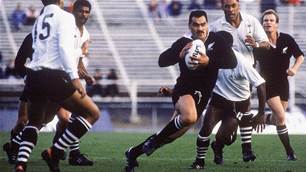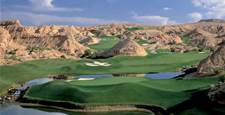There’s nowhere else in the golfing world quite like it.
Lying just south of the internationally renowned Melbourne Sandbelt, Victoria’s Mornington Peninsula has made a global name for itself as a ‘must-visit’ golfing destination boasting a plethora of world class courses.
Then, there are the off-course attractions. Foodies will love the equally world-class wineries (celebrated for their chardonnay and pinot noir in particular) and great restaurants where you can indulge in local epicurean delights. It's also the perfect place to switch off by soaking in steamy hot springs, laze on a beach or relax in a luxury hotel.
But if you’re reading this it is the golf that comes first, and every other attraction is the icing on the cake.
The Mornington Peninsula boasts the greatest concentration of Top-100 ranked courses in Australia. Of the 20 courses featured over the following pages, 16 of them are ranked in Golf Australia magazine’s Top-100 Courses in the country, while the remaining courses are highly regarded public access layouts.
By all means, enjoy the food, the wine and the sights, but we’re sure the golfing delights of the Mornington Peninsula will have you enthused for a return.
PENINSULA KINGSWOOD COUNTRY GOLF CLUB
Lying at the northern gateway to the Mornington Peninsula, and on the southern fringe of the Melbourne Sandbelt, the Peninsula Kingswood Country Golf Club (pictured above) is home to one of Australia’s most exciting 36-hole complexes.
While the original North and South Courses were highly acclaimed for many years, the club undertook a multi-million-dollar course redevelopment, which was completed and officially for play in 2019. It has since thrust the spectacular redesign onto the world stage.
The merger of Peninsula and Melbourne’s Kingswood Golf Club in 2013 led to the new club commissioning the then Ogilvy, Clayton, Cocking and Mead (OCCM) design firm to totally revamp the North and South Courses, with Mike Cocking taking responsibility for much of the epic project that ultimately created two new courses.
Difficulty should never be used in assessing the quality of a golf course, and when a club focuses on making their course harder, it usually spells the end for hole width and, ultimately, strategy. With the Peninsula Kingswood club giving the design team free reign to create the best holes they could, width and strategy were re-introduced throughout the property. Much of the width, offering multiple playing lines on most holes, was created by clearing non-indigenous vegetation, which unveiled the natural heathland of the area and is one of the unforgettable elements of a round here.
Then there are the special extras. The Pure Distinction bentgrass putting surfaces are quick, firm and smooth … a familiar trait throughout the Sandbelt. The flash bunkering is spectacular, while the beautifully trimmed short grass areas ‘connecting’ green complexes with the next tee adds to the splendour of the design.
Peninsula Kingswood is a private member’s club, but interstate visitors can apply for a tee time. There is also luxury accommodation on-site.
“Mornington continues to impress. The closing holes of both nines have been improved with the construction of new green complexes, while the 19th hole addition is one of the most visually spectacular holes on the Mornington Peninsula,” - Top-100 judge, James Walsh.
MORNINGTON GOLF CLUB
Mornington is one of the oldest on the peninsula having been established nearly 120 years ago and has been on its current site overlooking Port Phillip Bay since 1946.
The club entrusted the job of designing the course to former gun amateur golfer, Gus Jackson, and the first nine holes officially opened for play four years after the site was chosen.
Seven decades on, the course continues to evolve and has found success and popularity in recent years on the back of impressive redesign work and wonderfully manicured playing surfaces. The course debuted at No.84 in Golf Australia magazine’s Top-100 Public Access Courses in 2019. Two years later, it stormed up the same list to No.64, making it one of the most improved layouts in the country. This year, its climb continued into the top half of the ranking to No.47.
“Mornington continues to impress. The closing holes of both nines have been improved with the construction of new green complexes, while the 19th hole addition is one of the most visually spectacular holes on the Mornington Peninsula,” noted Top-100 judge, James Walsh.
The construction of the 19th hole, which is perched near the cliff tops on the edge of Port Phillip Bay, has been a masterstroke by the club. It has allowed them to take individual holes out of play for extended periods for redevelopment work but still provide a memorable and challenging hole as a stand-in.

Contour Golf Design architect Ben Davey in collaboration with Cape Wickham Links co-designer Darius Oliver are the minds behind the redesign, which has already seen considerable improvements made.
The latest hole to be remodelled is the par-4 6th, which is now a wonderful semi-blind two-shotter featuring high and low road playing lines on the wide, undulating fairway. The high road has its risks but a better view of the elevated green, while the low road has little risk from the tee, but an obscured view and longer shot into the putting surface. It’s a terrific hole that keeps Mornington’s improvement curve heading in the right direction, and ensures more golfers visiting the Peninsula will be calling into Mornington for a game.
DEVILBEND GOLF CLUB
Devilbend Golf Club is one of the lesser-known Mornington Peninsula clubs, especially to those living outside Victoria, but is certainly worth a visit.
Opened for play in 1975, the layout was designed and constructed by Eric Horne, who decades earlier had worked alongside Sam Berriman, the acclaimed long-time curator and builder of Huntingdale and a host of other Victorian courses.

While the land at Devilbend was not ideal for golf – combining several steep hills with swampy lowlands – Horne was still able to create a good, challenging course that has gradually been improved bit-by-bit during the past four decades. During that time all the greens have been reconstructed, the fairways converted to Santa Ana couch and bunkers added.
While the hills at Devilbend provide the platform for some attractive holes, the standout hole plays across a slope and adds to the challenge of hitting an accurate approach. The 408-metre par-4 12th is rated the hardest hole on the course for good reason. Played from an elevated tee, your drive needs to find the right half (or high side) of the fairway to avoid a lake to the left. With the ball sitting above your feet (for right-handers) you need to hit a straight second to keep your ball out of the bunkers that surround the green and to leave a straightforward approach up the length of the angled green.
BAY VIEWS GOLF COURSE
Bay Views is another peninsula layout, like Devilbend, that lies across dramatically undulating terrain. In fact, of all the courses featured here, Bay Views offers some of the best elevated regional and bay views. Hence the name.
Situated on steep sloping land at Arthur’s Seat, Bay Views rises above the surrounding residential areas providing golfers with Port Phillip Bay vistas all the way to Sorrento.

The acclaimed Vern Morcom created the original layout in the 1950s and, despite it not being on ideal golfing land, there are plenty of good holes to pique your interest including its collection of diverse par-3s.
From the challenges presented by the 180-metre downhill 11th, with its dramatically contoured putting surface, to the short, well-bunkered 15th and 17th (123 and 135 metres respectively) holes, which hint at Melbourne Sandbelt origins in their design.
Bay Views’ presentation has improved markedly since Golf Services Management took over the running of the course in 2014. This investment saw the layout climb to within just a few points of cracking a spot in the 2023 ranking of the Top-100 Public Access Courses in Australia.
ROSEBUD COUNTRY CLUB
Rosebud is one of the peninsula’s original clubs and is enjoying a resurgence in popularity after hosting the PGA Tour of Australasia’s TPS Victoria event for the past three years.
The TPS tournament is played on a Composite layout of the club’s North and South Courses, both of which have been significantly redeveloped in recent years, with designers Ogilvy, Cocking and Mead (OCM) bringing in changes that really impressed this magazine’s Top-100 Public Access Course ranking judges.
“The design changes of both Rosebud courses have been enhanced further by the great work undertaken by Ian Todd, the former long-time course superintendent at Victoria Golf Club, and his team,” ranking judge Nathan Burgess said of Rosebud after its North and South Courses grabbed No.27 and No.56 respectively in the list published earlier this year.
Fellow judge Phil Nicholls added: “The South Course is much improved, and I would recommend playing this fine layout in the morning, grabbing a bite of lunch and heading out on the North Course in the afternoon.”
With rippling fairways, a handful of semi-blind tee shots, expansive bunkering, wider playing lines and exciting green complexes throughout the two courses, it’s no wonder Rosebud is gaining wide acclaim.
SORRENTO GC
Many of Melbourne’s well-to-do keep membership at Sorrento Golf Club, and it’s also a popular second club for members of Sandbelt clubs. Not only is Sorrento a terrific place to dine, shop and wander around, it’s home to a gem of a golf course tucked away behind town with a beautiful country charm to it.
Founded in 1907 (originally as Sorrento and Portsea GC, which is interesting given recent speculation of a merger between the two), Sorrento is laid out on rolling land dotted with pine trees and low scrub. The course is short by modern standards yet is a tight test characterised by its quintet of fantastic short holes, while the bunkering is also a standout feature. As is the conditioning, which might just be so good as to put Sorrento among the best presented layouts in the nation.
Sorrento is a private club, but visitors can enquire about available tee times Monday, Tuesday afternoon and Thursday.
PORTSEA GOLF CLUB
Portsea Golf Club used to be regarded as one of the best-kept golfing secrets on the Mornington Peninsula.
Not anymore though. Today, a modern $12 million clubhouse with 24 four-and-a-half-star hotel rooms – offering panoramic views over the course and beyond, gives Portsea a resort feel despite remaining a private golf club.

It is a visually striking layout near the tip of the peninsula bordering the Point Nepean National Park. Classically designed, Portsea has evolved from a nine-hole track created by Scottish professional Jock Young in 1926 to a par-71 that was ranked No.37 in Australia by this magazine in 2022.
Commonwealth Golf Club’s long-time secretary Sloan Morpeth created 18 new holes for the club in 1965, which remained unchanged for more than three decades when Michael Clayton was commissioned to remodel the layout. Holes were lengthened, bunkers re-shaped and large tracts of thick ti-tree removed to enhance the view from many of the tees. The design firm of Ogilvy, Cocking and Mead (OGM) was recently appointed course consultants to the club to oversee further enhancements to the course.
Portsea’s sometimes dramatic topography and the occasionally strong breezes offset the fact it is not long by modern standards. That said, it’s no soft touch.
Built among rolling sand dunes and protected by thick native coastal shrubbery and deep bunkers, Portsea offers several approaches up steep ravines as well as a handful of blind tee shots throughout the journey.
Take the short but genuinely tough par-4 10th hole. At 256 metres from the back pegs, there is certainly a temptation to have a crack at the green with the driver. But anything less than perfect will probably finish in the massive scheme of bunkers, surrounded by dense scrub, to be found on the low left side of the fairway.
THE DUNES GOLF LINKS
This Tony Cashmore-designed gem at Rye has been a favourite stop for golfers visiting the Mornington Peninsula more than. 25 years now.
The course, opened for play in 1997, was the first of a generation of links courses to the built in Australia over the next decade, including Links Kennedy Bay in WA, the Barnbougle courses in Tasmania as well as neighbouring layouts like those found at The National and Moonah Links.

The layout rocks and rolls across exposed, undulating, sandy terrain and is framed by craggy, rustic bunkers. It has its quirks, but those quirks make Cashmore’s creation so memorable.
But at its heart is 18 holes easily enjoyed and playable for casual golfers, aspiring to be better golfers and those that have already mastered the ability to get the ball in the middle of the clubface.
It is very much a second shot course where the inviting wide fairways tempt you out of your comfort zone and question your ability to leave your ball in the best possible location for your next shot.
One of the many highlights of a round here is playing the stunning 179-metre 17th – a ‘Redan’ style par-3 described by Tom Watson as “an exquisite golf hole”. The pin position dictates whether a high fade or a curling draw is the preferred play and any shot shaped correctly has every chance of catching the contours of the green and feeding close to the flag.
MOONAH LINKS
Back in 1998, the then named Australian Golf Union (AGU) had a masterplan to create two championship courses, a state-of-the-art teaching and practice facility as well as a resort and residential development in the heart of the Mornington Peninsula.
It was the birth of Moonah Links and it became known as the ‘Home of Australian Golf’. Millionaire businessman Paddy Handbury owned the property and oversaw the completion of the Open Course.
Designed specifically to host the Australian Open on a regular basis, the Peter Thomson, Mike Wolveridge and Ross Perrett-designed par-72 opened for play in 2001. The layout was routed over, through and around rolling sand dunes that are a real feature of this Cups region of the peninsula.

For the average golfer, the Open Course provides a stiff, but fair, challenge. Indeed, at 6,810 metres from the championship markers it is one of the longest courses in the country. The peninsula is prone to being buffeted by strong winds and the Open Course really bares its teeth on such days. But the strength of the challenge here is the enjoyable aspect of any round on the Open Course.
Some call it a “beast”. Thomson referred to his creation as a “leviathan”. Either way, you know if you can play to your handicap here you have indeed played well.
Perhaps the lasting impression the Open Course will leave is of the par-5 18th hole, which stretches to 582 metres from the plates and features no less than 11 bunkers scattered between tee and green. The rolling nature of the fairway means many of these bunkers are obscured from view, while the catchment area surrounding these sandy pits is wide and penal.
The Legends Course may have been the second course opened at Moonah Links but today it is generally ranked slightly higher than the neighbouring Open Course. Legends opens with a series of holes that rise and fall through valleys and in between long and dense stretches of ancient Moonah trees.

The course then takes on a new complexion as the Moonah trees thin out and wild, rugged bunkering, high sand dunes alongside gently rolling fairways give rise to a links-style course.
Very little earth was moved in the creation of the Legends course, which gives the impression it has been in the ground here for more than a few decades. Perrett did a wonderful job in routing the course to follow the pitch and roll of the land, sticking to the low ground wherever possible, while the aforementioned bunkering is not only intimidating but it adds to the visual appeal of the layout.
EAGLE RIDGE GOLF COURSE
All of the courses that have been added to the Mornington Peninsula landscape during the past 30 years can be found within 10 minutes’ drive of each other in what has become the famed ‘Cups’ area.
Lying right in the heart of this area is the much under-rated Eagle Ridge course, which was extensively redesigned in 1999 by Pacific Coast Design course architect, Phil Ryan. In 2007, all 14 fairways were converted to Santa Ana couch, while the greens were changed to Penncross bentgrass. The grass conversion has been a resounding success and, 15 years on, the playing surfaces are excellent. In fact, the turf quality at Eagle Ridge would be the envy of any big private city club.

Eagle Ridge is definitely a fun alternative to the neighbouring links layouts. Trouble lurks on most holes, with well-bunkered greens and fairways common throughout.
The bunkering of this par-72 is plentiful and can be visually intimidating, especially if you find yourself in the sand with more than a wedge required to reach the green. Ryan’s sandy hazards are a mix of small deep pots and expansive stretches of irregular shapes. The downhill par-3 8th hole, for example, features a pot bunker in front of the tee, while a 60-metre sprawl of sand lies just beyond. A further six bunkers can be found around the edge of the large green.

Eagle Ridge’s penal bunkering is no more evident than when you head down the final stretch to the clubhouse. The 522-metre par-5 18th is a great closer that calls for length and accuracy as well as good strategy. A steep hill descending to the fairway may assist the longer drive but that’s all the help any player gets here. Large bunkers hug the edges of the fairway for most of the remaining 200-plus metres to the green. The green is massive and almost entirely surrounded by a picturesque lake, with more than two-thirds of the green’s fringe sloping steeply down to a watery grave.
If you make a mess of the final hole, you can always stick around for a few beverages and some live music in the Peninsula beer garden.
ST ANDREWS BEACH
Designer Tom Doak’s second Australian design behind Barnbougle Dunes promised to be something special when it opened for play in 2005.
Doak created a course with plenty of space, making it very playable and enjoyable for all golfers.
For the better player the key is in the playing lines from the tees and the angles those lines subsequently leave into the greens. Some holes are wide open and exposed; others funnel between dunes or between stands of untouched vegetation. The bunkering is wild and rugged, while the green complexes will gather or repel a bouncing approach shot depending on the line of attack.
“The land at St Andrews Beach was so good for designing a golf course that it became difficult to decide which holes we couldn’t build,” Tom Doak said in an interview with Golf Australia magazine. “There are natural golf holes laid out there of all shapes and sizes.
“In some cases, we just had to find the right spot to put a green, locate the nearest high point near that green to put the next tee and the following hole would present itself.
“I can’t help but feel that Alister Mackenzie would be mad that he never got the chance to design a course on land this good.”

Doak doesn’t design his courses with an end length, or par number, in mind. He lets the terrain dictate how the course will flow.
For example, at St Andrews Beach he created some superb short par-4s. While the 279-metre 2nd earns considerable acclaim, I lean to the slightly shorter 14th as an even better hole. The tiny green lies at the end of a wide, split level fairway, surrounded on three sides by dunes. The right side of the putting surface features a steep drop off, which can repel a mis-hit nearly 15 metres down a hill into high, wispy rough. This is a wonderful hole that can be played three or four different ways and all result in the same score.
THE NATIONAL GOLF CLUB
The National Golf Club is the biggest and most impressive golf destination on the Mornington Peninsula.
In fact, it is the biggest golf club in the Southern Hemisphere with three courses – the Old, Gunnamatta and Moonah – surrounding its luxurious Cape Schanck clubhouse, while the most recent addition to The National portfolio is its Long Island course, which is the next-door neighbour to the previously mentioned Peninsula Kingswood CGC at Frankston at the northern gateway to the region. All four courses are ranked in the country’s Top-50 by Golf Australia magazine.
The National opened in 1987 with the original Robert Trent Jones Jnr layout, now known as the Old course, before expanding in 2000 with two more layouts built on the western side of the current clubhouse. The Moonah course, created by Greg Norman and Bob Harrison, and the Tom Doak-crafted Gunnamatta layout that replaced the Peter Thomson, Mike Wolveridge and Ross Perrett-designed Ocean Course a few years ago.
The Old course is vastly different to its neighbours. Thick bush and scrub line both sides of most fairways, which rise and fall between the tees and dramatic-shaped greens.
By far the most famous hole on the Old Course is the par-3 7th, which traverses a ravine to a green with two distinct halves separated by a large spine. The 7th sits on a part of the property affording the best views of Bass Strait and often plays into the wind, meaning the 139 metres can still require a long iron to find the target.
The Moonah course is so named for the gnarled, weathered trees of the same name dotted across the layout. There are unique holes but no bad ones as each shot has you thinking and trying to navigate a path to the green that avoids the wind, the deep, natural bunkers and the thick rough flanking most fairways.
Doak’s adjoining Gunnamatta Course is closer to the sea than the Moonah layout but sits on less dramatic terrain. This gave Doak some freedom to craft some really cool holes like the short but dramatic par-4 2nd, the par-4 8th with its boomerang-shaped green and the long par-3 11th hole, which was inspired by the design of the ‘Calamity’ hole at Royal Portrush in Northern Ireland.
The National is a private golf club but interstate visitors can request a tee time via the club’s website. Victorian residents must be invited and play with a club member.
RACV CAPE SCHANCK RESORT
Almost a decade before the Mornington Peninsula golf course building boom began in the late ‘90s, famous American designer Robert Trent Jones Jnr left his golfing imprint on the landscape.
Of course, he created the Old Course for The National GC and, next door, he designed a public access course across similarly dramatic ground.
“It is an undulating, emerald oasis carved out of giant sand dunes and Ti-tree and will take artful playing,” Jones said of his Cape Schanck design. “It is built on a high plateau of beautiful links land. The Cape course is not long. It is designed for skilful players who have to use a great deal of finesse. It is designed to be a fun yet challenging and intricate course."
The fairways rise and fall violently and quickly as they cut through the Ti-tree and ancient Moonah trees. It's hard to believe this land could be used for anything but golf.
Jones uses bunkering, the lie of the land and the natural vegetation to create a test. Only once does he use water to make the golfer second-guess his ability to successfully hit the green.
Although Jones didn’t overdo the bunkering, there are still more than 70 of them between the 1st tee and 18th green. Some are small and seemingly innocuous while others are big enough to warrant a camel escort. All are unique in shape and strategically positioned to make you think with every shot you take from the tee and fairway.
FLINDERS GOLF CLUB
Nestled on the cliffs at the entrance to Victoria’s Westernport Bay, Flinders Golf Club would never been considered in the same category of long and demanding that is a trait of most of its neighbours lying to the west in the heart of the peninsula.
But Flinders offers plenty of challenges and picturesque sights as it winds out to the edge of the cliffs, then uphill and inland before returning to the relatively flat, but enjoyable, finishing stretch of holes. It is an excursion that golfers have been enjoying for nearly 120 years.

Flinders is perhaps the least known of the Mornington courses simply because it is a lone layout on the eastern side of the peninsula and certainly ranks as a hidden gem for those that have not travelled extensively throughout the region.
Five -time Open Champion Peter Thomson once wrote Flinders is a unique coastal course that could not be labelled a links “neither is it woodland or marsh,” he wrote, “that is perched high on the cliff top, making it a distant cousin of Pebble Beach and a relative of Muirfield.”
“Flinders is friendly yet full of surprises and intrigue,” he concluded.
Flinders stretches to 5,277 metres from the tips and is a par 69. But these numbers mean very little in this part of the world where Mother Nature plays such a significant hand in the difficulty of a round. In fact, Thomson honed his wind-beating skills here prior to each of his Open victories.
Set across gentle sand hills above Bass Strait, Flinders has evolved over more than a century of play but some of the most significant changes to the layout came back in 1926 at the suggestion of the legendary course designer Dr Alister MacKenzie. The ‘Good Doctor’ during his visit to Australia had enough time to convince the committee at Flinders to make several changes to the course including the conversion of the then par-3 4th hole into a
par-4.

There has been a raft of very good design improvements made to the layout in recent years, with a new green complex for the 16th hole being the latest big project for the course’s greens staff.
WHERE TO STAY

Ideally located to fully explore all the golfing riches, and more, of the Mornington Peninsula, the Rosebud Motel has 12 ground floor rooms and a poolside cabin overlooking the solar heated pool.
The Rosebud Motel is surrounded by all the action located directly opposite the beautiful Port Phillip Bay, whether it is fishing, jet skiing (launching ramp directly opposite) or Peninsula Hot Springs (eight-minute drive) or golf.

The Rosebud Motel specialises in golf packages, either small or large groups, with an itinerary tailored to suit every individual golfers’ needs. As well as providing a comfortable and relaxed stay, the motel will also organise all courses for you and provide you with a cooked or continental breakfast daily.
Golf packages start from $120 per person per night for six nights’ accommodation and five rounds of golf (including breakfast), twin and double basis.
For more details or to book visit www.rosebudmotel.com.au
MERCURE PORTSEA
Mercure Portsea features 24 boutique-style rooms with each having a private balcony or terrace, ensuite and large LCD television. It’s also only a short distance to Point Nepean, Portsea and Sorrento villages.
Stay and play packages start from $200 per person twin share (Sunday to Thursday) including one nights’ accommodation, 18 holes at Portsea for two players and breakfast for two.
For more details and to book, visit www.portseagolf.com.au
PEPPERS MOONAH LINKS RESORT
Peppers Moonah Links Resort blends the Open and Legends Courses with luxury accommodation, a day spa and a la carte restaurant.
There are 70 deluxe rooms and suites, all with balconies or terraces overlooking the stunning golf courses or central putting green.
For more details or to book, www.moonahlinks.com.au or www.peppers.com.au/moonah

1.PENINSULA KINGSWOOD CGC
Green fees: Upon application.
2. MORNINGTON GC
Green fees: $65 (18 holes, weekdays to May 31, 2023); $80 (weekends); $40 (weekdays from June 1), $60 (weekends).
3. DEVILBEND GC
Green fees: $45 (18 holes, weekdays); $65 (Saturday); $55 (Sunday).
4. BAY VIEWS
Green fees: $48 (18 holes); $45 (booked online via website).
5. ROSEBUD CC
Green fees: $85 (18 holes, weekdays); $95 (weekends). $110 (18 holes peak season).
6. SORRENTO GC
Green fees: Upon application. Limited tee times, Monday, Tuesday and Thursday.
7. PORTSEA GC
Green fees: $100 (18 holes, weekdays); $110 (Sunday & public holidays).
8. THE DUNES GL
Green fees: $87 (18 holes, weekdays); $105 (weekends & public holidays).
9. MOONAH LINKS
Green fees: $110 (18 holes, May to September), $220 (all day play); $125 (October to April), $250 (all day play).
10. EAGLE RIDGE
Green fees: $60 avg. (18 holes, weekdays); $80 avg. (weekends).
11. ST ANDREWS BEACH
Green fees: $105 (18 holes).
12. THE NATIONAL GC
Green fees: $280 (18 holes, interstate visitors, Monday, Tuesday & Thursday only), $420 (36 holes in one day); $140 (18 holes accompanied member’s guest). At Long Island: $180 (18 holes, interstate visitors, Monday, Tuesday & Thursday only), $270 (36 holes in one day); $100 (18 holes accompanied member’s guest).
13. RACV CAPE SCHANCK RESORT
Green fees: $90 (18 holes, weekdays, non-RACV members); $105 (18 holes, weekends, non-RACV members).
14. FLINDERS GC
Green fees: $53 (18 holes, weekdays); $75 (weekends); $85 (peak season).
Related Articles

International Spotlight: Omanu Golf Club

Celebrity Kiwi couple tee off in paradise












